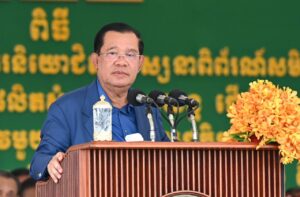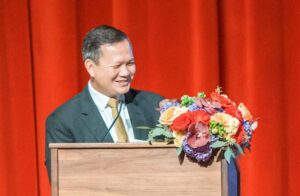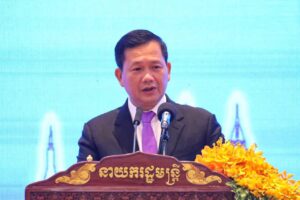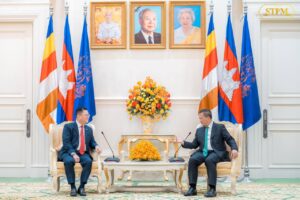Selected Comments Samdech Moha Bovor Thipadei Hun Manet, at the official inauguration the “Kampot Multi-Purpose Port” (KMP) [Unofficial and translations]
[2]
(1) The goal of being a high-income country is for people to have prosperous life
The ultimate goal is to develop into a high-income country by 2050. What does high income mean? It is not to attain high income for the state, but a high average income for the people. This means that by 2050, we want our people to have a richer life, the next generation to have more potential and be able to benefit from the peace that we have achieved since 1998. In this sense, it is necessary to ensure peace, stability, political, social and economic stability, and the formulation of the right policies […] since with the correct policies, but without favorable conditions, such as wars, countries would not be able to accomplish the policies. And vice versa, though with stable economy and peace, we would not be able to accomplish progress for incorrect policies […]
(2) In order for the economy of the whole country to grow, the economy of each capital and province has to grow
For the whole of Cambodia to prosper, each province and capital grows. We want the country to develop as a whole. Our country has 25 provinces/capitals. We have more than 200 districts. We have up to tens of thousands of villages. So, we need each cell to grow […] so that the economy of the whole country grows. Until the economy of each capital and province grows, and the more each of them grows, together they will make one strong economic growth. In order for our country to become a high-income country, the income of each province and/or capital must be high (and each of them are) adding up together. This means that the people in each province/capital have earned more incomes. This is the main goal of the government’s policy to make the country a high-income country by 2050 […]
(3) Setting out a policy to suit the potential of each province
In order to set the right policy for each province/capital, we need to clearly analyze what each province has as potential? We cannot set a goal to develop strong cultural tourism in Kampot, nor can we develop a blue water port in Siem Reap. (These policies) do not fit with the target province’s potential. We need to see what each province, each capital has, that we can reap the potentials. What are their natural resources and geographical locations good for? How to make a profit from them? […] in order for a country to be stronger, each province and/or capital should not match to win or lose, but we must join forces, and take each existing potential together, and make them an interwoven plan […]
(4) Develop a master plan for the four coastal provinces and form a synergy to compete
There are only four provinces in the Kingdom of Cambodia that are bordering with the sea – Kep, Kampot, Koh Kong and Sihanoukville […] these four provinces must be united as one force for Cambodia. We are putting together an interwoven master plan that will be announced soon for the four coastal provinces […] in which, each has its own unique characteristics, but also some characteristics that need to be developed together […] as a coastal province – what potential does Kampot have? We have connected Kompot by waterway with the world. The development of the waterway transportation system that we are building ports in Sihanoukville and in Koh Kong is necessary in this effort. Why do we have to build ports? […] they are keys to serve the growth of logistics and transportation, or firstly for logistics management and secondly, for the growing demand of industry, manufacturing, and thirdly, for tourism […]
(5) The master plan for the four coastal provinces must interweave
In the organizing plan, the Kampot (multipurpose port – KMP) needs not compete with ports in Sihanoukville or Kep. Thus, the planning of the ports’ dynamics needs to interweave. What does that mean? It requires a master plan for these four provinces, rather than planning separately […] if the four provinces, which have the same potential, fail to cooperate, they will not be successful […] the word synergy – where one plus one for four times culminate in six or seven, not four […] the planning for Kampot requires the province to cooperate with Sihanoukville in areas such as industry, manufacturing and tourism. In this regard, instead of doing it alone, Kampot must be part of the interwoven plan with its neighbors […]
(6) No more license for casinos in Kampot and Kep, black pepper with GI, and interconnected co-energy ports plan
Regarding the planning for Kampot province […] (which I have mentioned,) concerning industries, manufacturing, agroindustry, logistics and tourism […] there have been inquiries about whether it is possible to apply for a casino license in Kampot province […] from today onwards, except for those to operate at the border passes, there will be no license granting for casinos in Kampot province […] and the same is true for Kep province regarding the casino license […] we welcome requests for investments in hotel, special economic zone, industry, manufacturing, agriculture, […] for instance, there are some special agricultural produce, such as black pepper which has a GI (geographical indication) […] and secondly, about Kampot multi-purpose port, in Cambodia there are […] level-1 ports, level-2 ports […] and we are planning to interconnect them […] smoothly […] to be a joint energy (in logistics and transportation) […]
(7) The four coastal ports plan is not just in theory
I would like for us to firstly think of an interwoven plan for the nearby ports, such as the Sihanoukville Autonomous Port, which is the same type of port, and secondly, the ADB-funded tourist port nearby to see how can they cooperate with each other […] there is another deep-water logistics port which is about 20 km from here […] in which case, instead of having two deep-water ports together […] we may figure out which port can focus on what, for instance minerals […] in the time to come, when we have the possibility to start exploring for oil in the overlapping areas, then we shall be figuring out which port will handle the petrochemicals to come from refining oil […] the plan is not theoretical. This plan is something we have actualized obviously. Some people say that I have talked so much in theory. I do not think so. I talk about what have been doing. All ports are licensed and under construction […]
(8) Interweaving between ports and with land, air and water infrastructure system
In this plan, we do not think only of interweaving between ports. We need to think about interconnectivity with other infrastructure systems, including land, air and waterways, as well as other types […] the post-war Royal Government under the leadership of Samdech Akka Moha Sena Padei Techo Hun Sen, as well as those before it, has been expanding and strengthening the road network […] to better connect the country’s blood veins. We think of waterways, landways, and railways. Kampot is a province connected by the existing road from the northern (economic) pole to the southern (economic) pole […] we are planning to upgrade further – firstly, strengthen the safety system (for the railway) and secondly, we prepare the existing railway to allow trains to run from 60km/h to 80km/h and focus on transporting more goods […] to realize transporting and logistics system […] let us focus on building more expressways to facilitate transportation. As for high-speed rail, let us wait till later stage […]
(9) Building expressways and shortcuts
Regarding the expressways, we are building them along the line of the existing roads, such as National Road 4, but also considering more shortcuts. We have recently opened (some straight-cut roads) such as the National Road 10 that runs straight from Koh Kong to Poipet, whereas in the past, we had to go down Phnom Penh first (to connect to another national road) because there were no other options. We are now thinking of a shortcut from Poipet to Siem Reap, which will make traveling shorter […] (Deputy Prime Minister and Minister of Land Management, Urban Planning and Construction) HE Say Sam Al is planning (a road for cyclists) along the beach, from Kep to Koh Kong […] whereby, in commune and villages, we have built roads in asphalt, concrete, and laterite […]
We are working on connecting between Kompot and the port by rail […] we think about the waterway transport as some tourists fly to the Kang Keng airport (in Sihanoukville) then take motor boats to the islands or nearby areas […] there may be more hotels here for tourists in the time to come […] where the people in Kampot will find more works available. Now we have the shipping and ports here, and the factory are on their ways […] however, we are not going to build another international airport in Kampot. We have one in Sihanoukville already. We cannot have two in such a close distance […]
(10) The Funan Techo canal (FTC) is a BOT with Cambodian companies owning 51% stake
Allow me to take this opportunity to thank the Cambodian people – both inside the country and all over the world, the people of Kampot included, who understand the enormous (social, economic and logistics) values of the Funan Techo canal […] I am calling our people to continue to support this historic project […] even up to this moment, there are still (opposition politicians) who propagate that the RGC is borrowing foreign money to invest (in this canal). Let me stress that it is not true. (Firstly,) it is a project to be invested with a BOT formula […] secondly, while initially this investment was 100% foreign, now the project will have 51% stakes owned by the Cambodian investors […]
I would like to announce that (firstly, the construction ceremony will be launched) on August 5, 2024 […] we have already determined the location, and have materials, tools, means in place […] the Cambodian people shall believe that this project is not for the benefit of any country. It is for the benefit of the country and the people of Cambodia now and into the future […] and secondly, our people should not believe some politicians who distorts the facts and incite the people to lose faith and/or to protest against and not to support this project […]
The Royal Government will arrange a technical solution and will solve the policy for the people who will have to bear impacts (from the project). According to the survey report that I have here from (Deputy Prime Minister and First Vice Charman of the Council for the Development of Cambodia) HE Sun Chanthol, there are 1640 houses and may be a little more than 1,600 to more than 2,000 […] I hope that when we start the project, the figure will not change to more […]
The government is not taking the land from the people to sell to the private sector […] we are not just focusing on exploiting the potential of the canal. The state will have the state-owned companies who will reap the commercial benefits and place them in the state’s pockets. What does the state use the benefits for? […] for the 7th legislative term Royal Government, we have launched policies to expand health, cash support programs, scholarship training program, and increase the salary of civil servants […] for instance we have just provided some financial support to the (education sector) […] to extend the study time for schools from primary to grade 12 […]
Every province must enforce the law-and-order command against the Samurai sword gangs […] for this full term, and the terms to come […] I have appealed to the judiciary that there could be no case of (such law abusing acts that) the authorities arrested is to be released without clear legal reason […] we must strictly enforce the law […]
(11) Investors and speculators should not buy land along the FTC project
I am calling on people who do not live in the delta (of the FTC), especially investors and/or land speculators, not to come and cause problems in the delta […] please help the state and our country build this project successfully […] If you really love the nation, and wish the nation to be independent in transportation, the southwestern province to directly benefit from economic development, the whole country to benefit from this historical canal, and to see a new history in the land of Angkor, where this generation of Cambodians build (- please help the state) […]
The Royal Government, Samdech Techo and I are just small actors. Samdech Techo brought forward the initiative and I happen to lead the implementation. There are officials, authorities and people supporting and working together on this historic project. It is a joint project of the nation. We are just proud to be a part of it […] everywhere that we are putting up the projects, (there always are impact). However, we do not want to see a third hand who, either for political or other gains, cause destruction (to this effort) […]./.






